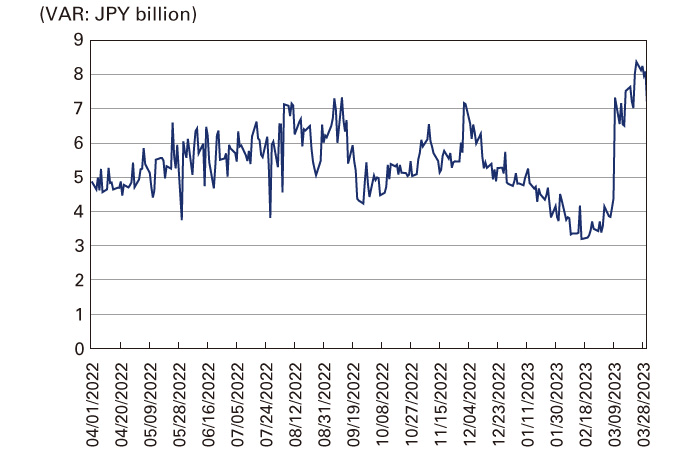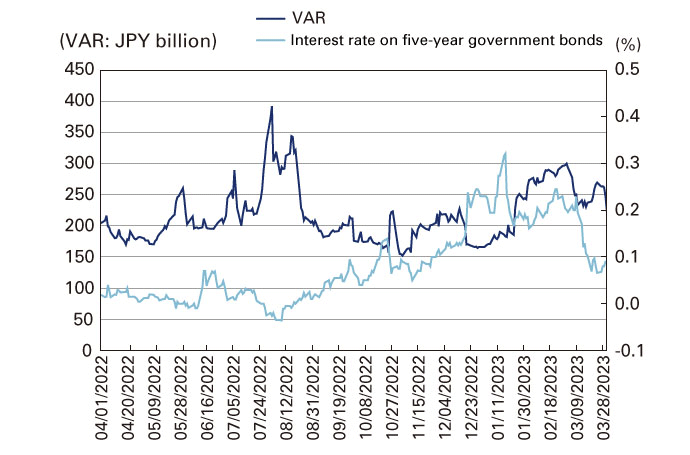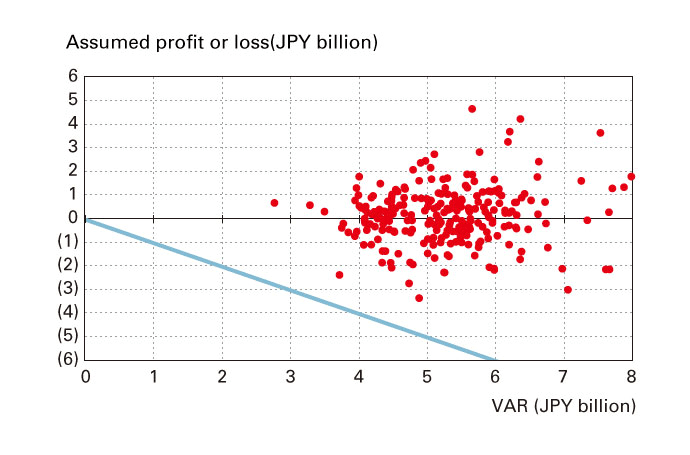Market Risk Management
Basic Approach
We define market risk as the risk of losses incurred by the group due to fluctuations in interest rates, stock prices, and foreign exchange rates. Our definition includes the risk of losses incurred when it becomes impossible to execute transactions in the market because of market confusion or losses arising from transactions at prices that are significantly less favorable than usual.
Mizuho Financial Group manages market risk for the Mizuho group as a whole. Specifically, Mizuho Financial Group establishes the fundamental risk management policy for the entire group, manages the market risk of our principal banking subsidiaries and other core group companies, and monitors how the group's market risk is being managed as a whole.
Market Risk Management Structure
Our Board of Directors determines basic matters pertaining to market risk management policies. The Risk Management Committee of Mizuho Financial Group broadly discusses and coordinates matters relating to basic policies in connection with market risk management, market risk operations, and market risk monitoring.
The Group CRO is responsible for matters relating to market risk management planning and operations.
The Risk Management Department of Mizuho Financial Group is responsible for monitoring market risk, reporting and analyzing, making proposals, setting limits and guidelines, and formulating and implementing plans relating to market risk management.
As for the situation of market risk, the Risk Management Department submits reports to our President & Group CEO on a daily basis and to our Board of Directors on a regular basis. For the purpose of managing the market risk of our principal banking subsidiaries and other core group companies, the Department regularly receives reports from each of them to properly identify and manage their market risk. These subsidiaries and core group companies, which account for most of the Mizuho group's exposure to market risk, establish their basic policies based on ours, and their boards of directors determine important matters relating to market risk management.
Market Risk Management Method
To manage market risk, we set limits that correspond to risk capital allocations according to the risk profile of each of our principal banking subsidiaries and other core group companies and thereby prevent the overall market risk we hold from exceeding our financial strength represented by capital and other indicators. The amount of risk capital allocated to market risk corresponds to value-at-risk (the "VAR") and additional costs that may arise in order to close relevant positions.
Setting Limits
When the above mentioned limits are set, various factors are taken into account, including business strategies, historical limit usage ratios, risk-bearing capacity (profits, equity capital, and risk management framework), profit targets and the market liquidity of the products involved. The limits are discussed and coordinated by the Risk Management Committee, discussed further by the Executive Management Committee and then determined by our President & Group CEO. For trading and banking activities, we set limits for VAR and for losses. For banking activities, we set position limits based on interest rate sensitivity (10 BPV) as needed. An excess over any of these limits is immediately reported and addressed according to a pre-determined procedure.
Monitoring
To provide a system of mutual checks and balances in market operations, we have established middle offices specializing in risk management that are independent of front offices which engage in market transactions and of back offices which are responsible for book entries and settlements. When VAR is not adequate to control risk, the middle offices manage risk using additional risk indices, carry out stress testing, and set stop loss limits as needed. We monitor market liquidity risk for individual financial products in the market while taking turnover and other factors into consideration.
Status of Mizuho Financial Group's Market Risk
Value–at–Risk
We use the VAR method, supplemented with stress testing, as our principal tool to measure market risk. The VAR method measures the maximum possible loss that could be incurred due to market movements within a certain time period (or holding period) and degree of probability (or confidence interval).
Trading activities
VAR figures for our trading activities are based on the following:
- historical simulation method;
- confidence interval: one-tailed 99.0%;
- holding period of one day; and
- historical observation period of three years.
The following tables show the VAR figures for our trading activities by risk category for the fiscal years ended March 31, 2021, 2022, and 2023 and as of March 31, 2021, 2022, and 2023:
VAR by risk category (trading activities) (JPY billion)
| Fiscal 2020 | ||||
| Daily average | Maximum | Minimum | At March 31 | |
| Interest rate | 4.3 | 8.6 | 1.7 | 2.6 |
| Foreign exchange | 0.7 | 1.3 | 0.3 | 0.4 |
| Equities | 1.1 | 6.6 | 0.1 | 0.7 |
| Commodities | 0.0 | 0.0 | 0.0 | 0.0 |
| Total | 5.4 | 9.1 | 2.4 | 2.7 |
| Fiscal 2021 | ||||
| Daily average | Maximum | Minimum | At March 31 | |
| Interest rate | 3.8 | 5.7 | 2.8 | 4.0 |
| Foreign exchange | 0.5 | 1.5 | 0.3 | 1.0 |
| Equities | 0.8 | 4.9 | 0.2 | 1.1 |
| Commodities | 0.0 | 0.1 | 0.0 | 0.0 |
| Total | 4.3 | 10.2 | 2.9 | 5.3 |
| Fiscal 2023 | ||||
| Daily average | Maximum | Minimum | At March 31 | |
| Interest rate | 4.6 | 7.2 | 2.7 | 7.2 |
| Foreign exchange | 0.8 | 1.6 | 0.4 | 0.9 |
| Equities | 1.1 | 2.0 | 0.4 | 1.0 |
| Commodities | 0.1 | 0.7 | 0.0 | 0.7 |
| Total | 5.3 | 8.3 | 3.1 | 7.0 |
The following graph shows VAR figures for our trading activities for the fiscal year ended March 31, 2023:
Fiscal 2022 VAR (trading activities)

The following table shows VAR figures for our trading activities for the fiscal years indicated:
VAR (trading activities) (JPY billion)
| Fiscal 2020 | Fiscal 2021 | Fiscal 2022 | Change | |
| As of fiscal year end | 2.7 | 5.3 | 7.0 | 1.7 |
| Maximum | 9.1 | 10.2 | 8.3 | (1.9) |
| Minimum | 2.4 | 2.9 | 3.1 | 0.2 |
| Average | 5.4 | 4.3 | 5.3 | 1.0 |
Non–trading activities
The VAR figures for our banking activities are based on the same conditions as those of trading activities, but the holding period is one month. In addition, as for risk management of banking activities, it is important to properly measure interest rate risk so that we calculate interest rate risk using appropriate methods such as recognizing demand deposits as "core deposits."
The following graph shows the VAR figures for our banking activities excluding our cross-shareholdings portfolio for the fiscal year ended March 31, 2023:
Fiscal 2022 VAR (banking activities)

The following table shows the VAR figures for our banking activities for the fiscal years indicated:
VAR (banking activities) (JPY billion)
| Fiscal 2020 | Fiscal 2021 | Fiscal 2022 | Change | |
| As of fiscal year end | 249.4 | 209.7 | 223.5 | 13.7 |
| Maximum | 501.7 | 321.9 | 392.2 | 70.3 |
| Minimum | 224.0 | 191.0 | 152.1 | (38.8) |
| Average | 346.5 | 266.0 | 217.6 | (48.3) |
Characteristics of VAR model
VAR is a commonly used market risk management technique.
However, VAR models have the following shortcomings:
- By its nature as a statistical approach, VAR estimates possible losses over a certain period at a particular confidence level using past market movement data. Past market movement, however, is not necessarily a good indicator of future events, particularly potential future events that are extreme in nature.
- VAR may underestimate the probability of extreme market movements.
- The use of a 99.0% confidence level does not take account of, nor makes any statement about, any losses that might occur beyond this confidence level.
- VAR does not capture all complex effects of various risk factors on the value of positions and portfolios and could underestimate potential losses.
Cross–shareholdings portfolio management activities
We take the market risk management approach with use of VAR and risk indices for cross-shareholdings portfolio management activities to properly manage stock price risk. Specifically, we monitor VAR measurements and the state of risk capital on a daily basis.
Moreover, in order to control stock price risk, we are working on the reduction in cross-shareholdings through careful negotiations with counterparties.
Back testing
In order to evaluate the effectiveness of market risk measurements calculated using the VAR method, we carry out regular back tests to compare VAR with assumptive profits and losses. Assumptive profits and losses accounts for general market risk. The graph below shows daily VAR of trading activities for the fiscal year ended March 31, 2023 and the corresponding paired distribution of profits and losses.
We had zero cases where losses exceeded VAR during the period.
In addition, we conduct evaluations of the assumptions related to the VAR models. Based on the number of times losses exceeded VAR through back testing and the results of the evaluation of the model assumptions, we will make adjustments to the models as appropriate.
Changes to fundamental portions of the VAR models are subject to the approval of our Group CRO.
Fiscal 2022 back testing

Note: We conduct our back testing and assess the number of cases where losses exceed VAR based on a 250 business day year. The expected average number of instances where one-day trading losses exceeded VAR at the 99.0% confidence level is 2.5.
Stress Testing
Because the VAR method is based on statistical assumptions, we conduct stress testing to simulate the levels of losses that could be incurred in cases where the market moves suddenly to levels that exceed these assumptions. The stress testing methods we use include the calculation of losses under scenarios in which stresses are applied to interest rate risk and stock price risk based on current and projected economic conditions, historical market events, etc.